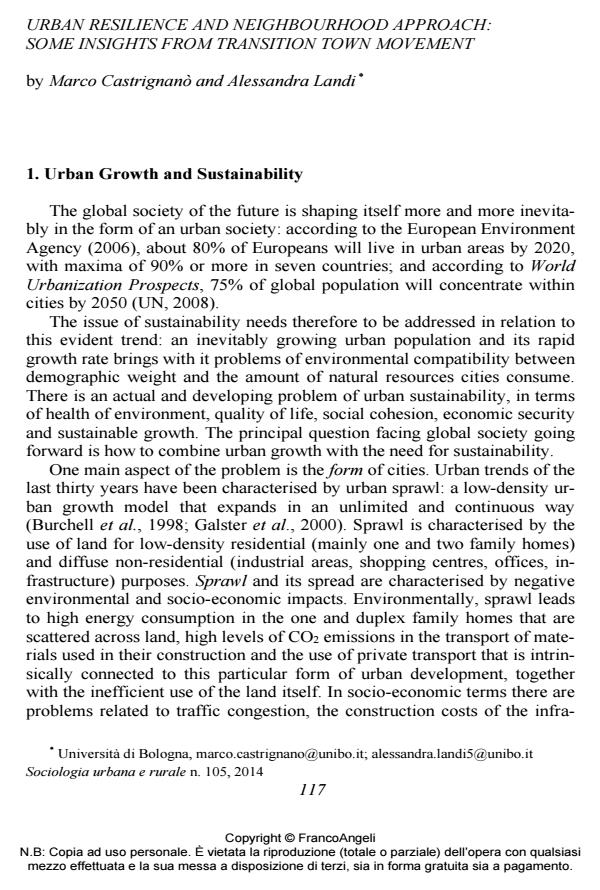Urban Resilience And Neighbourhood Approach: Some Insights From Transition Town Movement
Titolo Rivista SOCIOLOGIA URBANA E RURALE
Autori/Curatori Marco Castrignanò, Alessandra Landi
Anno di pubblicazione 2014 Fascicolo 2014/105 Lingua Inglese
Numero pagine 12 P. 117-128 Dimensione file 209 KB
DOI 10.3280/SUR2014-105008
Il DOI è il codice a barre della proprietà intellettuale: per saperne di più
clicca qui
Qui sotto puoi vedere in anteprima la prima pagina di questo articolo.
Se questo articolo ti interessa, lo puoi acquistare (e scaricare in formato pdf) seguendo le facili indicazioni per acquistare il download credit. Acquista Download Credits per scaricare questo Articolo in formato PDF

FrancoAngeli è membro della Publishers International Linking Association, Inc (PILA)associazione indipendente e non profit per facilitare (attraverso i servizi tecnologici implementati da CrossRef.org) l’accesso degli studiosi ai contenuti digitali nelle pubblicazioni professionali e scientifiche
La progressiva crescita delle città pone inevitabilmente problemi di eco-compatibilità: in una prospettiva di sviluppo urbano sostenibile, un ritorno alla città compatta sembra essere l’univa via perseguibile, per diverse ragioni. Una prospettiva di ricompattamento urbano richiede di focalizzare l’attenzione sui quartieri: ricorrendo ad alcuni concetti degli studi di Sampson, si evidenzia come le Transition Towns possano essere lette in una prospettiva di Neighbourhood e come la letteratura sulla resilienza di comunità presenti elementi di sostanziale continuità con il neighbourhood approach.
Keywords:Quartiere, resilienza, sostenibilità urbana, città compatta, efficacia collettiva, Transitions Towns
- Adger W.N. (2000). Social and Ecological Resilience: are they related? Progress in Human Geography, 24. DOI: 10.1191/03091320070154046
- Allard S.W., Small M.L. (2013). Reconsidering the Urban Disadvantaged: The Role of Systems, Institutions, and Organizations. The ANNALS of the American Academy of Political and Social Science, 647. DOI: 10.1177/000271621347931
- Benight C. (2004). Collective Efficacy following a Series of Natural Disasters. Anxiety, Stress, and Coping, 17. DOI: 10.1080/1061580051233132876
- Bromet E., Goldgaber D., Carlson G., Panina N., Golovakha E., Gluzman S., et al., (2000), Children’s well-being 11 years after the Chernobyl catastrophe. Archives of General Psychiatry, 57. DOI: 10.1001/archpsyc.57.6.56
- Brown D., Kulig J. (1996). The Concept of Resiliency. Theoretical Lessons from Community Research. Health and Canadian Society, 4.
- Burchell R. W., Shad N.A., Listokin D., Phillips H., Downs A., Seskin S., Davis J., Moore T., Helton D., Gall M. (1998). Cost of Sprawl - Revisited. Washington DC: National Transportation Research Board, National Research Council.
- Burdett R. (2008). The versatility of future cities. London, 29th July 2008, Interview available at www.dac.dk/en/dac-cities/sustainable-cities-2/experts/richard-burdett-theversatility-of-future-cities/?bbredirect=true.
- Castrignanò M. (2012). Comunità, capitale sociale e quartiere. Milano: FrancoAngeli.
- EEA (European Envinronment Agency) (2006), Urban Sprawl in Europe - The Ignored Challenge. EEA Report 10.
- Cork S. (Ed.) (2009). Brighter Prospects; Enhancing the Resilience of Australia. Australia 21.
- Folke C. (2006). Resilience: the emergence of a perspective for social-ecological systems analyses. Global Environmental Change, 16. DOI: 10.1016/j.gloenvcha.2006.02.00
- Galster G., Hanson R., Ratcliffe M.R., Wolman H., Coleman S., Freihage J. (2000). Wrestling Sprawl to the Ground: Defining and Measuring an Elusive Concept. Housing Policy Debate, n. 12.
- Gans H. (1962). The Urban Villagers: Group and Class in the Life of Italian-Americans. Glencoe New York: Free Press.
- Giddens A. (1990). The Consequences of Modernity. Stanford, CA: Stanford University Press and Cambridge: Polity.
- Harvey D. (2012), Rebel Cities: From the Right to the City to the Urban Revolution. London, New York: Verso.
- Holling C.S. (1973). Resilience and stability of ecological systems. Annual Review of Ecology and Systematics, 4. DOI: 10.1146/annurev.es.04.110173.00024
- Hopkins R. (2008). The Transition Handbook: from oil dependency to local resilience. Cambridge: Green Books.
- Jacobs J. (1969). The Death and Life of Great American Cities. London: Penguin Books.
- Landi A. (2012). Verso una sociologia della sostenibilità: intervista a Colin Campbell. Sociologia Urbana e Rurale, 99. DOI: 10.3280/SUR2012-09900
- Norris F.H., Stevens S.P., Pfefferbaum B., Wyche K.F., Pfefferbaum R. (2008). Community Resilience as a Metaphor, Theory, Set of Capacities, and Strategy for Disaster Readiness. American Journal of Community Psychology, 41. DOI: 10.1007/s10464-007-9156-
- Park R.E., (eds.) (1952). Human Communities, The Collected Papers of R.E. Park, Hughes E.C., Johnson C.S., Masouka J., Redfield R., Wirth L. Glencoe: The Free Press. Petrillo A. (2013). La comunità dopo la comunità. (M. Castrignanò, Comunità, capitale sociale,
- quartiere, FrancoAngeli, 2012). Sociologia Urbana e Rurale, n. 100, pp. 127-129.
- Pfefferbaum B., Reissman D., Pfefferbaum R., Klomp R., Gurwitch R., (2005). Building Resilience to Mass Trauma Events. In L. Doll, S. Bonzo, J. Mercy, D. Sleet (eds.),
- Handbook on Injury and Violence Prevention Interventions. New York: Kluwer Academic Publishers.
- Rogers R. (2006). Richard Rogers. In AA.VV., Città, Architettura e Società, Vol. I. Venezia: Marsilio.
- Sampson R.J., Morenoff J.D., Gannon-Rowley T. (2002). Assessing ‘Neighborhood Effects’: Social Processes and New Directions in Research. Annual Review of Sociology, 28. DOI: 10.1146/annurev.soc.28.110601.14111
- Sampson R.J., Graif C. (2009). Neighborhood Social Capital as Differential Social Organization. American Behavioral Scientist, 52. DOI: 10.1177/000276420933152
- Sampson R.J. (2012). Great American City. Chicago: University of Chicago Press. DOI: 10.7208/chicago/9780226733883.001.000
- Sampson R.J. (2013). When disaster strikes, it’s survival of the sociable. New Scientist, 2916. DOI: 10.1016/S0262-4079(13)61183-
- Seyfang G. (2009a). Green Shoots of Sustainability. Permaculture, 62.
- UN (United Nations) (2008). World Urbanization Prospects: the 2007 Revision. New York: Department of Economic and Social Affairs, Population Division.
- Walker B, Salt D. (2006). Resilience Thinking: sustaining ecosystems and people in a changing world. Washington: Island Press.
- Wellman B. (1979). The Community Question. American Journal of Sociology, 84. DOI: 10.1086/22690
- Wirth L. (1938). Urbanism as a way of life. American Journal of Sociology, 44. DOI: 10.1086/21791
- Contestualizzare le politiche urbane di sostenibilità: il ruolo del capitale sociale territoriale Marco Castrignanò, Alessandra Landi, in PRISMA Economia - Società - Lavoro 1/2018 pp.26
DOI: 10.3280/PRI2017-001003
Marco Castrignanò, Alessandra Landi, Urban Resilience And Neighbourhood Approach: Some Insights From Transition Town Movement in "SOCIOLOGIA URBANA E RURALE" 105/2014, pp 117-128, DOI: 10.3280/SUR2014-105008